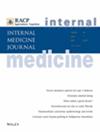Clinical outcomes and risk factors in patients with COVID-19 and autoimmune rheumatic diseases: insights from a major Australian hospital study
Abstract
Background and Aim
Patients with autoimmune inflammatory rheumatic disease (AIIRD) are at higher risk of severe infections because of their underlying diseases and immunosuppression. Our objective was to elucidate the epidemiological and clinical characteristics of patients with AIIRD presenting with COVID-19 and their relation to disease severity. We explored whether variables, including underlying diagnosis, disease-modifying antirheumatic drugs (DMARDs) and COVID-19 vaccine status, were associated with more severe forms of COVID-19 infection.
Methods
Between 1 January 2020 and 30 June 2022, 151 patients with AIIRD and COVID-19 infection were analysed using a binary regression model and a multinomial regression model.
Results
The average age was 61.5 years, and average Charlson Comorbidity Index (CCI) was 2.1; 106 (70.2%) patients were diagnosed with rheumatoid arthritis (RA), and 70 (46.4%) patients were receiving prednisolone. In the multivariable logistic regression model, ages between 50 and 69 years (odds ratio (OR) = 5.85; 95% confidence interval (CI) = 1.35–25.25) and older than 70 years (OR = 5.29; 95% CI = 1.21–23.14), prior prednisolone treatment (OR = 7.09; 95% CI = 2.63–19.11) and vaccination status including one and two doses (OR = 0.19; 95% CI = 0.05–0.69) and three and four doses (OR = 0.09; 95% CI = 0.02–0.35) were all statistically significant factors related to changes in the severity level of COVID-19.
Conclusion
Severity of COVID-19 infection in patients with AIIRD is affected by age, background steroid use and vaccination status. Factors including sex, comorbidity, diagnosis of AIIRDs and use of DMARDs, including conventional synthetic, biologics and targeted DMARDs, were not significantly associated with COVID-19 severity.

 求助内容:
求助内容: 应助结果提醒方式:
应助结果提醒方式:


